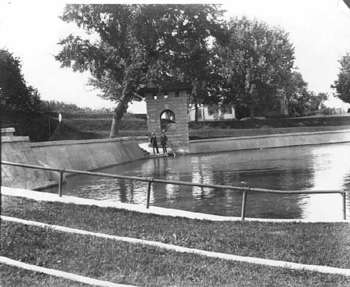Public shares hopes for Bureau of Mines/Coldwater site

The Camp Coldwater Spring Reservoir as it appeared in 1895.
On Monday, February 23, the National Park Service - Mississippi National River and Recreation Area (MNRRA) held an open house to gather community feedback on their proposal for the Bureau of Mines, or Coldwater, site.
The site is near the western edge of the Mississippi River between Minnehaha Park on the north and Fort Snelling on the south. It had been home to the United States Bureau of Mines, which occupied several mid-20th Century buildings on the site. But the U.S. Department of the Interior hopes the site can be restored to a more natural condition.
National Park Service historian John Anfinson said the open house was designed to get feedback on several key questions:
- As part of site restoration, what should happen to the structured, manmade water reservoir on the site?
- How should Coldwater Creek be directed to run from the reservoir over to the bluff?
- What measures should be taken to address historic resources on the site?
The Department of Interior's preferred alternative for the site is to remove all the above-ground structures and pavement on the site (which date only to the mid-20th century), and restore the site to a natural condition. Generally, that natural condition would be a prairie and oak savannah on the blufftop, with more trees and foliage remaining on the side of the river bluff. Restoration would also entail MNRRA gaining ownership of the land and developing a comprehensive plan for interpreting the site.
MNRRA sought input as part of two related processes. A review of the site under Section 106 of the National Historic Preservation Act will help determine the historic significance of the site and develop an agreement on how to treat those historic assets going forward. A related review of the site is taking place as part of an Environmental Impact Statement (EIS).
The sites significance runs deep. It holds strong resonance for many American Indian people. For example, the confluence of the Minnesota and Mississippi was believed by the Dakota to be the center of the earth, and bubbling springs were held in special regard. Indeed, many of the attendees at the open house were representatives of the Native American communities, who expressed a desire to see the land transferred back to Native American control, as it was before Europeans settled the area.
Coldwater is also a key site in telling the story of early European settlement of the region. Along with the site of present-day Fort Snelling, this was the first outpost settled by Europeans in Minnesota. In the twentieth century, the site took on importance in the mining industry and for mine safety.
The public comment period will stay open until March 25, 2009. MNRRA officials are hopeful a final EIS can be completed in mid- to late June, with a comment period in July, and a record of decision in late 2009.
For more information, visit http://www.nps.gov/miss.